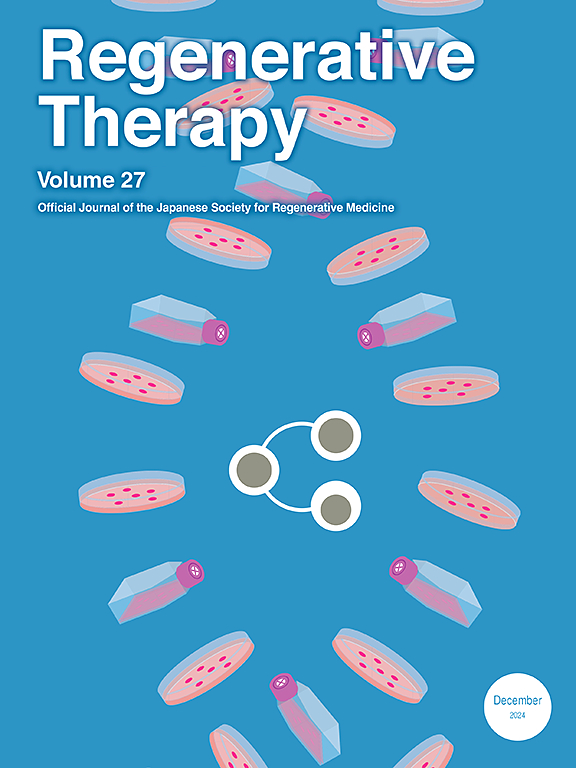一种温度敏感的壳聚糖水凝胶负载纳米氧化锌和外泌体从人脐静脉内皮细胞加速伤口愈合
IF 3.5
3区 环境科学与生态学
Q3 CELL & TISSUE ENGINEERING
引用次数: 0
摘要
糖尿病足溃疡(DFUs)的次优治疗结果是一个重大的全球性挑战。近年来,研究表明,在清创后加入外泌体(Exos)、纳米材料和水凝胶的新型敷料可以协同促进组织修复,这已被广泛认为是治疗DFUs的一个有前途的新兴趋势。本研究将氧化锌纳米颗粒(ZnO-NPs)、Exos和壳聚糖(CS)水凝胶(CS/ZnO-NPs@Exos)联合应用于糖尿病大鼠模型的全层皮肤缺损。将这种CS/ZnO-NPs@Exos水凝胶应用于伤口部位,以实现Exos的持续和长期释放,从而评估其治疗效果。该水凝胶显著提高了糖尿病皮肤损伤的伤口愈合率,减少了伤口部位的水肿、红斑和炎症渗出。这些作用的特点是增强再上皮化,减少炎症细胞的浸润,增加胶原沉积,增强伤口区域的血管生成。这可能与来源于人脐静脉内皮细胞(HUVECs)的Exos有关,其显著促进成纤维细胞的迁移和增殖。因此,CS/ZnO-NPs@Exos水凝胶为糖尿病伤口的治疗提供了一种新的治疗敷料,具有在临床实践中发挥关键作用的潜力。本文章由计算机程序翻译,如有差异,请以英文原文为准。

A temperature-sensitive chitosan hydrogels loaded with nano-zinc oxide and exosomes from human umbilical vein endothelial cells accelerates wound healing
The suboptimal therapeutic outcomes of diabetic foot ulcers (DFUs) represent a significant global challenge. In recent years, studies have indicated that novel dressings incorporating exosomes (Exos), nanomaterials, and hydrogels following debridement can synergistically promote tissue repair, which has been widely recognized as a promising emerging trend in the treatment of DFUs. In this study, a combination of zinc oxide nanoparticles (ZnO-NPs), Exos, and chitosan (CS) hydrogel (CS/ZnO-NPs@Exos) was applied to the full-thickness cutaneous defects in a diabetic rat model. This CS/ZnO-NPs@Exos hydrogel was applied to the wound site to achieve sustained and long-term release of Exos, allowing the evaluation of its therapeutic effects. This hydrogel significantly improved the wound closure rate in diabetic skin injuries and reduced oedema, erythema and inflammatory exudate at the wound site. These effects were characterized by enhanced re-epithelialization, reduced infiltration of inflammatory cells, increased collagen deposition, and enhanced angiogenesis in the wound area. This may be related to the Exos derived from human umbilical vein endothelial cells (HUVECs), which notably promote the migration and proliferation of fibroblasts. As a result, the CS/ZnO-NPs@Exos hydrogel offers a new therapeutic dressing for the management of diabetic wounds, with the potential to play a crucial role in clinical practice.
求助全文
通过发布文献求助,成功后即可免费获取论文全文。
去求助
来源期刊

Regenerative Therapy
Engineering-Biomedical Engineering
CiteScore
6.00
自引率
2.30%
发文量
106
审稿时长
49 days
期刊介绍:
Regenerative Therapy is the official peer-reviewed online journal of the Japanese Society for Regenerative Medicine.
Regenerative Therapy is a multidisciplinary journal that publishes original articles and reviews of basic research, clinical translation, industrial development, and regulatory issues focusing on stem cell biology, tissue engineering, and regenerative medicine.
 求助内容:
求助内容: 应助结果提醒方式:
应助结果提醒方式:


